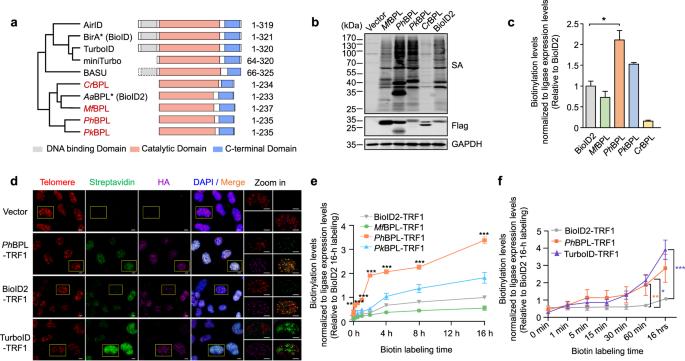快速接近标记系统 PhastID 将 ATP6AP1 鉴定为 Rheb 的非传统 GEF。
IF 28.1
1区 生物学
Q1 CELL BIOLOGY
引用次数: 0
摘要
Rheb 是一种小型 G 蛋白,它是雷帕霉素机理靶标复合体 1(mTORC1)的直接激活剂,可协调信号级联以响应营养物质和生长因子。尽管进行了大量研究,但直接激活 Rheb 的鸟嘌呤核苷酸交换因子(GEF)仍然不清楚,至少部分原因是作为信号转导标志的蛋白质-蛋白质相互作用(PPI)具有动态和瞬时的性质。在这里,我们报告了一种名为角越橘火球菌生物素蛋白连接酶(PhBPL)辅助生物素鉴定(PhastID)的快速、稳健的近距离标记系统的开发情况,并详细介绍了利用PhastID鉴定的Rheb-近距离蛋白网络在胰岛素刺激下发生的变化。我们特别发现溶酶体 V-ATPase 亚基 ATP6AP1 可与 Rheb 发生动态相互作用。ATP6AP1 可通过其最后 12 个氨基酸直接与 Rheb 结合,并利用其高度保守的 C 尾部的三天冬氨酸基团来增强 Rheb 的 GTP 负载。事实上,靶向 ATP6AP1 C 尾部可以阻断 Rheb 的活化,抑制癌细胞的增殖和迁移。我们的研究结果突显了 PhastID 在绘制活细胞中瞬时 PPIs 图谱方面的多功能性,揭示了 ATP6AP1 作为 Rheb 的非传统 GEF 的作用,并强调了 ATP6AP1 在通过 Rheb 整合 mTORC1 激活信号方面的重要性,填补了 Rheb/mTORC1 激活过程中缺失的环节。本文章由计算机程序翻译,如有差异,请以英文原文为准。


The rapid proximity labeling system PhastID identifies ATP6AP1 as an unconventional GEF for Rheb
Rheb is a small G protein that functions as the direct activator of the mechanistic target of rapamycin complex 1 (mTORC1) to coordinate signaling cascades in response to nutrients and growth factors. Despite extensive studies, the guanine nucleotide exchange factor (GEF) that directly activates Rheb remains unclear, at least in part due to the dynamic and transient nature of protein–protein interactions (PPIs) that are the hallmarks of signal transduction. Here, we report the development of a rapid and robust proximity labeling system named Pyrococcus horikoshii biotin protein ligase (PhBPL)-assisted biotin identification (PhastID) and detail the insulin-stimulated changes in Rheb-proximity protein networks that were identified using PhastID. In particular, we found that the lysosomal V-ATPase subunit ATP6AP1 could dynamically interact with Rheb. ATP6AP1 could directly bind to Rheb through its last 12 amino acids and utilizes a tri-aspartate motif in its highly conserved C-tail to enhance Rheb GTP loading. In fact, targeting the ATP6AP1 C-tail could block Rheb activation and inhibit cancer cell proliferation and migration. Our findings highlight the versatility of PhastID in mapping transient PPIs in live cells, reveal ATP6AP1’s role as an unconventional GEF for Rheb, and underscore the importance of ATP6AP1 in integrating mTORC1 activation signals through Rheb, filling in the missing link in Rheb/mTORC1 activation.
求助全文
通过发布文献求助,成功后即可免费获取论文全文。
去求助
来源期刊

Cell Research
生物-细胞生物学
CiteScore
53.90
自引率
0.70%
发文量
2420
审稿时长
2.3 months
期刊介绍:
Cell Research (CR) is an international journal published by Springer Nature in partnership with the Center for Excellence in Molecular Cell Science, Chinese Academy of Sciences (CAS). It focuses on publishing original research articles and reviews in various areas of life sciences, particularly those related to molecular and cell biology. The journal covers a broad range of topics including cell growth, differentiation, and apoptosis; signal transduction; stem cell biology and development; chromatin, epigenetics, and transcription; RNA biology; structural and molecular biology; cancer biology and metabolism; immunity and molecular pathogenesis; molecular and cellular neuroscience; plant molecular and cell biology; and omics, system biology, and synthetic biology. CR is recognized as China's best international journal in life sciences and is part of Springer Nature's prestigious family of Molecular Cell Biology journals.
 求助内容:
求助内容: 应助结果提醒方式:
应助结果提醒方式:


